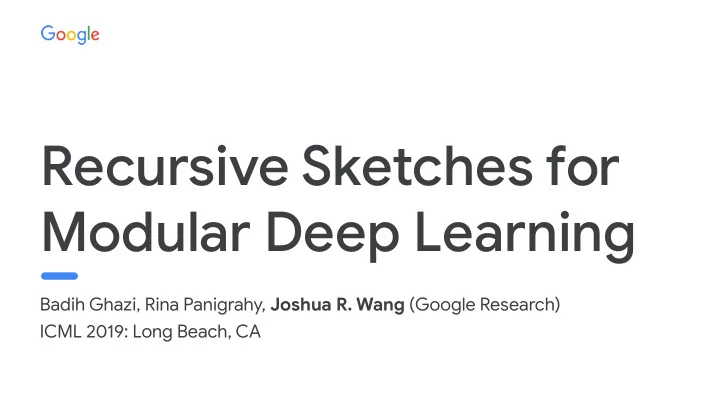

Recursive Sketches for Modular Deep Learning Badih Ghazi, Rina Panigrahy, Joshua R. Wang (Google Research) ICML 2019: Long Beach, CA
Object Recognition ● Rich literature around ML techniques for object recognition. ● Typical problem format. Input: Picture ○ ○ Output: Its object(s) Car: 99%
Object Memory ● This talk: twist on typical task. Input: Picture ○ ○ Output: Succinct representation of its object(s) Theorem. Can utilize model that solves the previous ● task as a primitive to solve this task.
Modular Networks 101 Output Module Output Module Cat Atuributes Wall Atuributes ● Module: independent neural network Cat Module Wall Module Wall Module component. ● Modules communicate via one’s output serving as another’s input. Edge Atuributes Edge Atuributes Edge Atuributes ● Intuition. Convolutional Neural Nets first find low-level objects (edge) and Edge Module Edge Module Edge Module build up to high-level objects (cat). The Input Data (Picture) Figure. Abstract view of modular network processing image of a room.
Recursive Sketches ● Our mechanism creates a sketch for each object detected by the modular network. Recursive, because sketch of an ● object incorporates the sketch of sub-objects. ● Sketching tricks: (i) apply random matrix and (ii) take a weighted sum. ● Input represented by top-level sketch .
Provable Sketch Properuies ● Attribute Recovery. Object attributes can be approximately recovered from top-level sketch. ● Sketch-to-Sketch Similarity. Two completely unrelated sketches have small inner product; two sketches with similar objects have large inner product. ● Summary Statistics. If there are multiple objects produced by same module, can approximately recover their summary statistics like count/mean. ● Graceful Erasure. Erasing all but sketch prefix, we still get above properties (but increase recovery error).
Recursable Dictionary Learning ● Previous slide properties required knowing random matrices chosen by the sketch. Recursable Dictionary Learning. Given enough sketches, can approximately ● recover the random matrices (and object attribute vectors). Dictionary learning “unwinds” one level of sketching recursion. ● ● Trickier than Classical Dictionary Learning. The noisy output becomes noisy input for the next stage, so the error guarantee and error tolerance must be of the same form.
Recap: Recursive Sketches ● Takeaway Message. Can utilize model that solves the object recognition as a primitive to generate useful and efficient sketches of inputs. ● Computing our Sketches. Built out of (i) apply random matrix and (ii) take a weighted sum. Let’s chat! Poster #73 @ Pacific ● Ballroom.
Recommend
More recommend